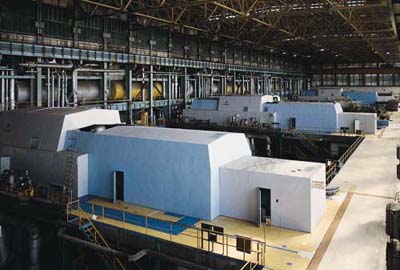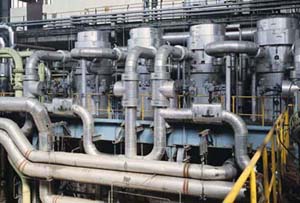 The joint-stock company CEZ is a Czech electricity company. It was founded on May 6, 1992 by the National Property fund of the Czech Republic as one of the new entities formed after the breakup of the former state-owned Czech Power Works.
The joint-stock company CEZ is a Czech electricity company. It was founded on May 6, 1992 by the National Property fund of the Czech Republic as one of the new entities formed after the breakup of the former state-owned Czech Power Works.
CEZ produces over three quarters of the electricity in the Czech Republic. It operates ten fossil power stations, thirteen hydro power stations, two nuclear power stations, two wind power stations, and one solar power station.
The Company also owns and operates the 220 and 400 kV high-voltage transmission grid. It does not distribute electricity directly to its final consumers, with the exception of certain large industrial customers in the Czech Republic. Most of its production is sold to eight regional electricity companies. The Company also realize import and export of the electricity. In addition, produces a minor portion of district heating.
CEZ strives to produce electricity in an economical and environmentally responsible manner.
CEZ´s stated capital (amounting to Kc 59,209 million as of December 31, 1998), turnover and net income establish it as a major company in the Czech Republic. The Company received excellent investment grade ratings: a BBB rating from Standard and Poor´s, an A-rating from the Japanese JBRI agency, and a Baa1 rating from Moody´s. CEZ was the first Eastern European industrial company to issue Eurobonds at European financial markets.
Having almost ten and half thousand employees and the capacity of 10,900 MW, CEZ ranks among the medium-sized electric utilities in the world
|
|
The Chvaletice Power Station
The Chvaletice Power Station is situated on the Labe River at the major railway line connecting Ceska Trebova and Prague, approximately twenty kilometers west of the town of Pardubice. It consists of four 200 MW units, totalling 800 MW of installed capacity. The power station was built between 1973 and 1979 on the grounds of the former Manganese and Pyrite Works which was then winding up its pyrite mining. Individual units were commissioned from the end of 1977 until the end of 1978. The completion of the Labe Water Route was linked to this project, as the brown coal burned at Chvaletice had been shipped there by river from the northern Bohemian town of Lovosice until the middle of 1996.
The station is operated from unit control rooms, with each room controlling two units. The PG 655 boilers are once-through, double-pass, dry-bottom boilers with a base furnace. They were made by Vitkovicke zelezarny. The boilers are further fitted with steam reheating, an economizer, rotary air heaters, two electric feed pumps, one turbo feed pump, and two three-sector electrostatic fly-ash separators. Rated at 655 tons of steam per hour, the boilers work at 88% efficiency. They are started with bunker fuel, each having six bunker fuel burners. The turbines are condensing, three-casing, and impulse turbines with eight steam extraction points. They are rated at 200 MW, with the rated speed of 3,000/min. The steam conditions are 16.8 MPa/535 °C. The units are fitted with type H 6688-2-VH 235 MVA turbo-alternators. The stator winding is cooled by the condensate, the remaining parts by hydrogen.
The terminal voltage of the generator, 15.75 kV, is transformed to 400 kV in a 250 MVA outgoing transformer. Each two units share one 400 kV outlet line. The output is then carried to the Týnec transformer station. The power station burns brown coal from northern Bohemia, with an average fuel efficiency of 10.6 GJ per ton and a sulphur content under 1.8%. The water source for the power station is the Labe River.
Compliance with the environmental protection regulations is guaranteed by several programs. The emission of sulphur dioxide will be reduced by desulphurization equipment based on the wet limestone washing method, which is presently under construction. The first stage (desulphurization of the 3rd and 4th units) will be completed by the end of 1997, the second stage in 1998. The main supplier of the equipment is the Finnish-Japanese consortium of IVO, Hitachi, and Itochu. One desulphurization unit will handle the flue gases from two power station units. This desulphurization unit’s speciality is that the desulphurized flue gases are discharged into the cooling towers. The emission of nitrogen oxides has been reduced to 400 mg/m3 by modifications to the boilers according to the project of DBW, a German company.
The dust emission is under 100 mg/m3. The electrostatic separators by Lurgi work with a 99.6% efficiency. The power station operates a network of seven emission-monitoring stations in its surroundings; the network is fully compatible with the AIM (Automatic Emission Monitoring) of the Czech Hydro-Meteorological Institute.
Until recently, most of the solid waste had been water-sluiced to the storage pond on the site of the former manganese and pyrite open pit mine. The power station has started extracting fly-ash and clinkers by the dry method in the second half of 1997. A blending center is presently under construction which will produce the stabilized compound (a mixture of ash, water, lime, and industrial gypsum) to be used in the building industry or to be deposited in a solid form.
Generation Unit - Chvaletice
Installed capacity 4 x 200 MW
Years of commissioning 1977 - 1978
Desulphurized since 1997 (2 x 200 MW)
and by
1997 (2 x 200 MW)
|

|
|

|
Fossil power plants account for under 70% of the installed capacity of the CEZ Power Company. Brown coal is fired at most fossil power plants. The North Bohemian fossil power plants are situated in direct neighbourhood of brown coal mines.
Over the past seven years (1992-1998), the CEZ Power Company has implemented what probably is the biggest and fastest environmental programme in Europe. Within the framework of the programme, we have installed the total of 28 desulphurisation plants and 7 fluidised-bed boilers at out power plants. Moreover, ash precipitators have been reconstructed and power plant control systems have been modernised. The overall investment in modernisation and desulphurisation of fossil power plants amounted to CZK 46 billion. Thanks to the effort, the SO2 and ash emissions have been cut by 90% and those of NOX by 50%. Our power plants are thus currently fully comparable to similar sources anywhere in Europe.
The programme of modernisation and desulphurisation of fossil units of CEZ a.s.
Before the modernisation and desulphurisation programme of fossil power plants of CEZ was launched, the total installed capacity of these plants was 8,482 MW. We decided to shut down the most obsolete plants and to modernise and desulphurise the remaining facilities so that they met the new emission limits in force from 1st January 1999. The total of 6,462 MW of installed capacity have been desulphurised. For 5,930 MW of this, the so-called flue gas scrubbing technology has been used (the wet and semi-wet lime washing technologies having been applied for 5,710 MW and 220 MW respectively), 497 MW have been desulphurised by the replacement of obsolete boilers by modern fluidised-bed units and, finally, in the case of 35 MW another fuel has been used. Simultaneously with the progress of works on the cleaning of the more modern coal-fired facilities the phase-out programme for the oldest units has been launched. By the end of 1998, the total of 2,020 MW will have been phased out.
|
|

|
|
|
|
|
|
|
|
|
|
|
|
|
|
|
|
|
|
|
|
|
|
|
|
|
|
|
|
|
|
|
|
|
|
|
|
|
|
|
|
|
|
|
|
|
|
|
|
What do you think?
Please let me know by signing my guest book.
|
|